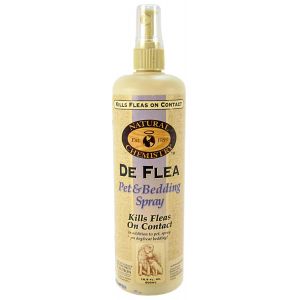Comparison of Modes of Action – DeFlea Products and Pyrethroid Containing Pesticides
 De Flea products use a different mode of action to kill fleas, ticks, lice, mites and other ectopatasites compared to pesticides containing pyrethroids (pyrethrum and similar chemicals.)
De Flea products use a different mode of action to kill fleas, ticks, lice, mites and other ectopatasites compared to pesticides containing pyrethroids (pyrethrum and similar chemicals.)
1. Mode of Action of Pyrethroids.
Pyrethroids are nerve poisons (neurotoxins) which affect the central and peripheral nervous systems, causing overloading of neural pathways and eventual death when administered at appropriate dose rates. (Observe flies spinning in circles immediately before expiring) These compounds, applied in appropriate doses effectively control ectoparasites on pets and humans, but they often exhibit detrimental side affects on the host, since the host has nerves and can be affected in the same manner as the pest if too much of the chemical enters the host.
Because of these potential side affects, manufacturers of products containing pyrethroids tend to use the lowest concentration of such chemicals in their products to still get acceptable results while avoiding harming the host animal or human administering the product. This leads to a secondary problem, namely the development of immunity in the target pest. The mechanism is simple to understand, as follows.
- Products contain just enough pyrethroids to kill an acceptable per cent of the target pest (generally 90% or more.)
- Upon application, a high percentage of the pests are killed, but many are only stunned. Shortly after treatment the stunned pests recover and fly off to find another or the same host.
- Over time, the surviving pests become immune to the concentration of pyrethroids in the product designed to kill them. They breed, and their offspring are also immune, leading to an increasing population of immune pests. Groomers are quite familiar with this problem because they often do a “white towel” test. After treatment they brush out the dead and apparently dead (stunned) pests (in this case fleas) onto a white towel, then observe how many stay on the towel. It is not unusual to observe from 30 to 50% of the” dead” fleas recover and fly away after 30 minutes. In the trade these are referred to as “ghost fleas.”
2. DeFlea Mode of action.
DeFlea contains no pyrethroids or related chemicals.
It is a proprietary, patented formula containing a surfactant (wetting agent)
and a weak acid which acts as a low grade pest killer. It works on
ectoparasites such as fleas, ticks, lice, and mites because they have
exoskelotons. Their vital organs are encased in an outer skeleton, compared
to mammals whose skeleton is inside and is covered and protected by a layer
of flesh.
The exoskeleton of the pest is a waxy substance which upon contact with DeFlea is softened and penetrated by the surfactant in DeFlea. The weak acid then disturbs the digestive system of the pest, and it promptly disintegrates. An important feature of the DeFlea mode of action and it’s ingredients is that it avoids both problems inherent in the pyrethroid containing products. At the concentrations of chemicals in the DeFlea ready to use formulas, or when the concentrate is diluted to use levels, the toxicity of the product in all
areas required to be analyzed by the EPA is category IV. This means that the probable effect on humans and the host animals is so slight that no warnings or first aid instructions are required on the label.
Further, when contacted by DeFlea the pest disintegrates in a matter of seconds. No development of immunity is possible when the target pest is completely destroyed.
Hence when groomers do the “white towel” test with DeFlea, There are no “ghost” fleas. All of the apparently dead fleas stay dead.





